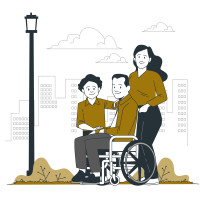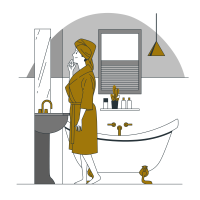The Palatine Hill
 Seven Hills of Rome
Seven Hills of Rome
One of the seven hills of Rome
The Palatine Hill is located between the Velabro and the Forum. It is one of the seven hills of Rome and also happens to be one of its oldest districts. It is now a large open-air museum that can be visited during the day. The entrance is from Via di San Gregorio (entrance fee), or you can walk to it by first entering the Forum Romanum (entrance fee) and then walking up the Clivo Palatino, which is to the right of the Arch of Titus.
The Palatine Hill is one of the main hills in Rome, but unlike the Capitoline and Aventine Hills, it is close to the Tiber River, though not directly beside it. Rising to a maximum height of 51 metres above sea level, it overlooks the Roman Forum on one side and the Circus Maximus on the other.
Two crests of the hill are separated by a dip; the most central and highest was known as the Palatium, while the other, on the slope that descends towards the Forum Boarium and the Tiber, was identified as the Germalus (or Cermalus). At the back it used to be connected to the Esquiline Hill by the Velia Hill, which was destroyed during the works for the Via dei Fori Imperiali.
The History
 Rome in the year of its foundation 753 BC
Rome in the year of its foundation 753 BC
Legendaries and the Archaic Period
The Palatine Hill is traditionally considered the site of the founding of Rome. However, recent excavations have allowed us to date the first evidence of settlement on the hill to around 1000 BC. The first settlement was a small village of a few hectares, surrounded by marshes and able to control the course of the Tiber. It was from this nucleated form of urban settlement that what has come down to us as "Roma quadrata" (Square Rome) was born, taking its name from the almost rhomboid shape of the upper part of the hill on which it was founded.
The Palatine hill and its settlement, probably first occupied by the Sicilians, became so important in the later development of the city that its two peaks, the Palatium and the Cermalus, were included in the original seven hills of the Septimontium. The Aeneid, like other legends, tells of Greek settlers from Arcadia, led by Evander and his son Pallas, who lived on the Palatine.
These 'Arcadians' were first encountered by Hercules and later by Aeneas. However doubtful the origins of such stories may be, it is certainly true that Evandro and Pallante, minor ancient gods, belonged to the ancient pantheon. Perhaps this area was frequented by Greek traders and sailors in very ancient times, before Magna Graecia was ever settled; this notion is somewhat supported by some archaeological discoveries made during several decades of the last century.
 Huts on the Palatine
Huts on the Palatine
According to Roman mythology, the Palatine Hill (more precisely, the marshy slope between the Palatine and Capitoline Hills, known as the Villabro) is where Romulus and Remus were found by a she-wolf. The wolf nursed them and kept them alive in the "Grotta del Lupercale", a cave that may have remained undiscovered until recently. According to the legend, the shepherd Faustrus discovered the babies and raised them with his wife Arca Larentia. When Romulus, as an adult, decided to found a new city, he chose this site (for a more detailed description of this myth, see "The Founding of Rome"). Romulus' house was actually a hut, rebuilt and restored several times, located on the northwest corner of the hill. The House of Augustus was later built on the site. Archaeological excavations in 1946 actually revealed the remains of an Iron Age hut on the site, fully confirming the legend.
The hill takes its name from the goddess Pales, in whose honour the ancient festival of Palilia (or Parilia) was established. Held on 21 April, the anniversary of the city's founding, the festival is thought by other scholars to derive its name from Palus, as many ancient peoples built structures on stilts. The most plausible explanation, however, is the root word pala, meaning "height."
The Lupercalia festival, associated with the mythical she-wolf, was also held here. From the Lupercalia Cave at the foot of the Palatine Hill, a procession of priests dressed in sheepskins and disguised as wolves would march towards the Tiber and then circle the hill. They whipped anyone who approached, especially women: a fertility ritual. The myth of the she-wolf giving birth to twins has been handed down through texts dating back to Tacitus and continues to this day.
Roman emperors built palaces on the Palatine Hill. The ruins of the palaces of Augustus, Tiberius and Domitian can still be seen today. The word "palace" comes from the Latin "palatium," which in turn comes from "palatino."
Augustus bought the residence of the orator Hortensius, adjacent to the so-called "House of Romulus" (which, according to legend, still existed in 31 BC). He bought neighbouring houses and extended them. He lived there but never made it into a real palace. Part of the residence was left to his wife Livia, known as the "House of Livia". Augustus also built the Palatine Temple of Apollo on the site, with its spacious portico and library.
 Interior of the House of the Griffins
Interior of the House of the Griffins
Republican era
During the Republican era, the Palatine Hill was home to various cults. Of particular importance were the cult of Magna Mater (Cybele), introduced from Asia Minor during the Second Punic War, and those of Apollo and Vesta, whose sanctuaries were founded by Augustus in his own home (Temple of Magna Mater, Temple of Apollo Palatinus, Temple of Vesta).
During the Republican era, the hill became the residence of the Roman ruling class. In fact, it was their home:
- Marcus Valerius Maximus, consul in 505 BC
- Gnaeus Octavius, consul in 165 BC
- Tiberius Sempronius Gracchus, father of the two famous tribunes of the plebs
- Marcus Fulvius Flaccus, consul in 125 BC
- Marcus Livius Drusus, tribune of the plebs in 91 BC
- Cicero and his brother Quintus
- Titus Annius Milo, friend of Cicero and murderer of Publius Clodius Pulcher, who also lived on the hill
- Quintus Hortensius Hortalus, orator, whose house was later bought by Augustus
- Mark Antony, the triumvir
- Tiberius Claudius Nero, father of Tiberius
Among the many Republican houses, remains have been found under the Domus Flavia, including the House of the Griffins and the Hall of Isaac, decorated with important frescoes.
 Stadium of the Domus Augustana
Stadium of the Domus Augustana
Imperial period
Rule period The great change in the history of the hill came when Augustus, who was born here, chose it as his home. He first bought the land from Hortensius and then expanded his holdings by acquiring other land nearby; the House of Augustus stood on the south-western part of the hill. After that, it became normal for later emperors to live on the Palatine Hill. The imperial houses built were those of Tiberius (the Domus Tiberiana, enlarged by Caligula), Nero (the Domus Transitoria and parts of the Domus Aurea), the Flavians (the Domus Flavia and the Domus Augustana) and Septimius Severus (the Domus Severiana and the Septizonium).
By the end of the Empire, the hill had become a collection of imperial buildings and gardens, forming a large place used by the emperors. After this, the word Palatium began to mean the 'palace' by excellence, first known as the imperial home, then used as a common word in all European languages. The relics of St Caesar of Terracina were transferred to the Roman Palatium between 375 and 379 AD, with the help of Pope Damasus I.
In the most suitable place, in the imperial chamber called Domus Augustana on the Palatine Hill, on the site where Villa Mills would later stand, an oratory for the martyr was built in this imperial residence; everyone called it 'San Cesareo in Palatio'.Here, according to official documents, is the place of Christian worship on the Palatine Hill that marks the Christian consecration of the imperial palace - a true palatine chapel that had long since replaced the pagan emperors' domestic lararium. The Oratory held images sent by Byzantium's newly elected emperors to Rome, further extended to other important cities across their vast empire.
 The Farnese Gardens
The Farnese Gardens
Medieval and modern times
In the 16th century the hill was owned by Alessandro Farnese. It then became the property of the Farnese family. The house played an important role in the construction of the Horti Palatini Farnesiorum (Farnese Gardens), which still exist in part over some of the remains of the Domus Tiberiana. The construction of the Horti Farnesiani was entrusted to Jacopo Barozzi da Vignola. Elisabetta Farnese, the last of the family, married Philip V of Spain in 1714.
She brought the Horti Farnesiani with her as a dowry and it became part of the Bourbon property in Naples. In 1861, Francis II, deposed King of the Two Sicilies, was forced to sell it to Napoleon III, a man with a deep love of ancient Rome. Pietro Rosa, known in France for his topographical studies of ancient Rome, was chosen by Napoleon to carry out the archaeological excavations on the Palatine Hill. Rosa later became the Superintendent of Excavations and Monuments of the Province of Rome and a Senator of the Kingdom.
He directed several important excavations, such as those of the Temple of Magna Mater, the Domus Tiberiana and the Domus Flavia. After Napoleon III's defeat at the Battle of Sedan in 1870 and his subsequent flight to England, he donated the Horti to the Italian State on 2 September that year for 650,000 lire. The plan was to create a large archaeological park to show off the kingdom, and was drawn up by the architects Rosa and the famous Italian leader Quintino Sella.
 Fresco in the House of Augustus
Fresco in the House of Augustus
Archaeological excavations in the area began to increase in the 18th century and reached their peak at the end of the 19th century, after Rome became the capital of the Kingdom of Italy. The discoveries continued in the 20th century with the houses of Augustus and XXI, and more recently with an underground chamber that can be taken for the Lupercale.
There are also other excavations that belong to the Palace of Tiberius under the Farnese Gardens. Between the Domus Flavia and the Domus Augustana, at the top of this hill, a villa called Stati Mattei was built in the 1500s. Charles Mills took over this house around 1830 and transformed it into an impressive neo-Gothic house.
A convent was built here at the end of the 19th century, but it was demolished in 1928 to make way for excavations. What remains of this building now houses the Palatine Antiquarium, with finds relating to the Palatine Hill - from its beginnings to the Republican period on the ground floor, and for the Emperors on the upper floor.
Services and Accessibility

Wheelchair accessible

Toilets

Bookshop

Refreshment point

Audioguide

